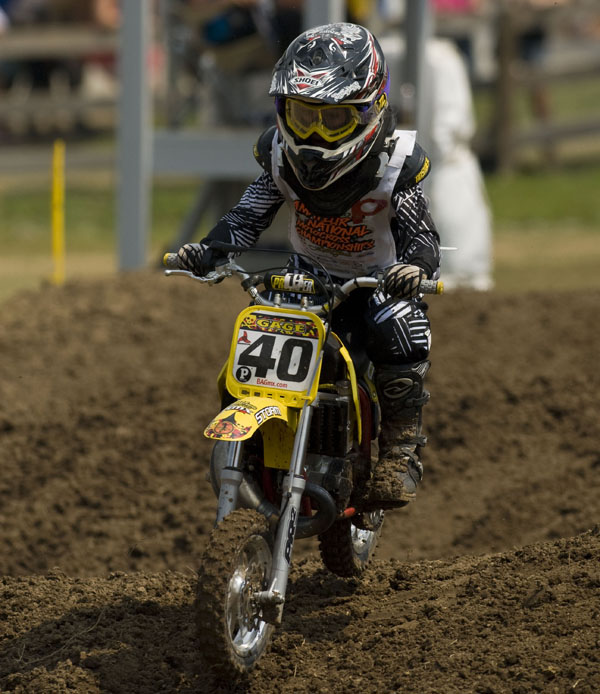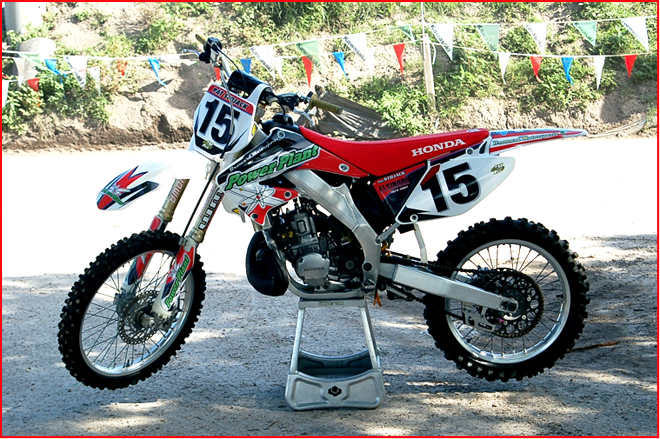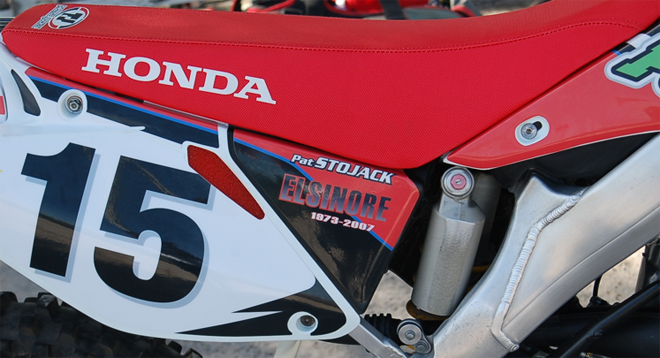A decision had to be made; buy a new bike or spend a few dollars on the present steed. Realizing that I indeed enjoy the bike, the decision became simple. And, if Honda no longer embraces my choice – who cares! I have tools… I know a guy….. In my hands the bike shall evolve with good-old American ingenuity. The irony is not lost on me – An American investing in an Asian canvas.
The Empire of a company Honda, created the Elsinore in 1971. Honda nurtured it for decades, commissioned some great riders to race it including Gary Jones, Marty Smith, Hurricane Hannah, Bad-Boy Rick Johnson, Professor Bailey, Stanton, the King MC, one Bradshaw, a Passionate Lusk, and some guy named RC, then for some reason Honda seemingly abandoned its legend since 2003 and then canceled production in 2007.. But why, why abandon this motocross lineage before its time? If it was a scooter or street bike it would be celebrated as a high water mark on Honda’s web-site. But as it stands, the Elsinore is barely mentioned. I could go buy a four-stroke, conform or be cast out. (G.Lee) I could go bowling ala Lebowski, or I could reinvent my bike.
Why not? I’ve done it before. I don’t see a ‘double pits to chesty’ in my future but that doesn’t mean I don’t appreciate this bikes attributes; it has a great chassis and ergonomics, after all it’s the same as the revered CR125 all-be-it with double the displacement. Its only real fault is the bottom end response. Why not just take my own bike to the next level? Enter the 2010 CR250R – they’re not just for Back-flips.
This model is a great canvas to apply my racing, riding and tuning knowledge. The same motives that fueled Honda back in ‘71; agility, speed, fun and reliability, fueled me as they are relevant today. This is no tribute to our sport’s past. This is no retro bike. This is a good bike made great, going forward, with no help of corporate brochure or marketing. Just the way it used to be and it shall be.
2010 CR250
ELSINORE, due respect for the lineage
• Timeline on Airbox
• Green on the Tank!
Ignition module.
Plenty of room – For 2010 the ignition module once located on steering pivot behind the front number plate is moved to the large airbox.
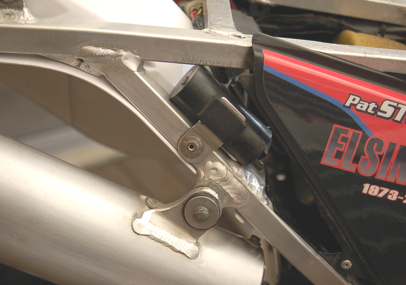
The Rectifier/regulator and Capacitor originally located on the left frame spar are moved as well. All aforementioned components are now located within the airbox utilizing the O.E. brackets and insulators. This move centralizes a few pounds of mass, allows ‘high use’ components to neighbor each other and also protect the expensive electronics from crashes, mud and power washers. Removal of the sub-frame is only slowed a few seconds by three multi-connectors. It is still silly/easy compared to a new EFI bike.
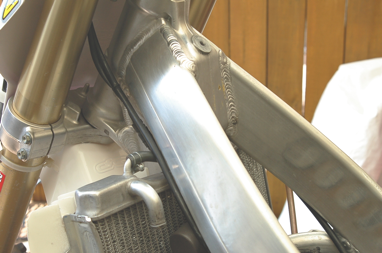
CR250r – A little ‘sweat equity’ and ingenuity results in the left frame spar void of the rectifier/regulator, capacitor and related brackets that were welded to the frame. Also removed is the wires that traverse the frame up to the steering head. Both hollow frame spars are filled with structural foam to limit resonance frequency throughout frame and handlebars.

Unsprung weight = bad, CR250r Caliper carrier assembly is lightened over 300grams and finished to look better than production. Stainless steel button head fasteners are used throughout including both rotors.
For 2010 Cycra Stadium plate added utilizing the Original Honda hydraulic line guide.
CR250r – Large flange Street bike Fairing fasteners used on all plastic locations. Here also visible is machined shortened ProTaper® bar mounts utilizing original Rubber mounts.
CR250r – 2010 Radiator shroud covers are aired out by opening up the small stock outlets as Honda has done to ventilate hot four-strokes (although this time it is just for asthetics.). Viewable in photo is the absence of the regulator/rectifier, capacitor and wiring usually found welded to this frame spar.
2010 CR250r Engine is modified to the core. Crank/transmission cases are strengthened in known weak spots and stuffed to alleviate performance robbing flex and resulting gear wear. Welding and stuffing is visible in photo in three places, left of drive shaft bearing, below thumb and front of finger.
2010 cases – At the Porting Station crankcase halves are analyzed with priority #1 being Volumetric efficiency. They are given location-specific textures based on tribology and thermal issues. Visible in photo is extensive Epoxy stuffing of redundant space fore and aft the cylinder center line. These areas are reduced and matched to cylinder sleeve and V-Force reed cage respectively. Top-end is installed on each case half and all transitions are matched. Engine is mock-built and cases further analyzed and ported. Case center flange surface is parallel verified and lapped. Oil drain holes are relieved to floor and lower bolt flanges are channeled to promote full drainage of transmission oil between rides. A magnet is placed inside to trap ferrous transmission particles.
CR250r Cylinder head – Engines do not recognize math, software or hole numbers, the only way the 2010 Elsinore is to achieve greatness was to cut a few heads and try them. Specifications get us tuners close but only through testing true 2010 Braaaaap realized
With power comes responsibility. The 2010 CR250r features contoured cooling passageways elevating all of Honda’s casting mismatches. All areas of the cooling system are analyzed and any flow obstructions are alleviated. Pictured is the water pump circuit being ported while cases are split. Later the impeller casting flashing and inner service hex-head is relieved. The coolant hose Tee interior is even fixed as is the head spigot and radiator spigots.
For 2010 CR250r. Completed right side engine including water pump painted in symbolic PowerPlant© Cool White epoxy paint. Note – Acorn nuts and copper washers on O-ringed cylinder. Oil filler cap is standard “lighter then billet” original plastic. Kick-starter anodized black to help ‘make it disappear’.
For 2010 Original Equipment Honda silencer, shortened to add low-end snap, packed and sealed.
249cc two stroke
2010 Cylinder features new Transfer port trajectory and improved exhaust valve design. (This is the second cylinder. After a few base cuts and port jobs the first cylinder is a fine paper weight or ‘a retired Guinea pig’) Visible is the 2010 RC Valve cover featuring Yellow Lexan® inspection window and sleek stainless Button head fasteners including stator cover. Also note – reliable stock expansion chamber.
Countershaft area.
Gearing is testament to how the 2010 edition runs. The stock CR250R required a tooth or two added to the rear sprocket due to the poor low-end. This engine utilizes an additional tooth on the countershaft. Due to its new-found torque and RPM ceiling this bike equals more go – less toe, each gear lasts substantially longer. Also shown in photo is aggressive wide foot pegs, thermal coated carburetor body, modified V-force reeds, shortened sub-frame arms, shimmed swing arm pivot, lightened O.E. shifter and painted HONDA inlay.
Additional Engine modifications include;
• Cylinder – stock transfer port trajectory error fixed, PowerPlant Porting© modified from mouths to ceilings to exits, exhaust port and bridge modified, Base machined, Exhaust valve stop silicon coated.
• Piston – skirt radius relieved and finished.
• Piston pin – custom ground for less weight.
• Connecting Rod – small end relieved and rod finished.
• Crankshaft re-balanced specific to new lightweight piston assembly. All Lobe voids stuffed with epoxy to a flush surface.
• Exhaust Valve (RC Valve) – welded and machined to create a truly functional valve to port relationship for much improved low-end performance.
• Cylinder deck – converted to O-ring for superior thermal sinking and low cost O-rings versus Honda steel gaskets.
• Stator Plate – adjustable, static timing marks added, two advanced, two retarded.
• Clutch – All aluminum drive plates for less gyroscopic forces/weight, Honda Blue clutch springs and stock springs @ 3 to 3 ratio. Filled with fresh $3 Type F ATF every ride. Clutch basket and inner cover – surface textured accordingly to know laws of Tribology
• Silencer – Original Honda unit shortened, repacked and resealed.
• Airbox Boot – internally re-shaped and textured
• Carburetor – Bell re-shaped including removal of unused circuit flange, venture bored .040”. Diet – Sunoco Race fuel, Jetted appropriately @ sea level and 40:1 Yamalube R©
• Reed/intake manifold – V-force assembly installed and port/matched to Honda intake manifold.
• Coolant is EngineIce and cap is a polished 16 lb Stainless steel American made Stant.
Additional 2010 chassis changes;
• Forks; O.E. with rider specific spring rate change, disc brake guard bosses removed and finished.
• Shock; O.E. with rider specific spring rate change.
• Linkage; packed with low drag grease.
• Wide Stainless steel IMS pegs
• Sub frame – rear lowered ½ inch.
• Cycra® White Stadium plate
• Throttle Jockey® HRC seat cover with ½ taller.
• Side Number plates – Factory located vents enlarged and finished with Honda Red foam to defuse air and water.
• Fuel Tank – Fuel anti-slosh foam inside, whole tank lowered 1/4 inch.
• Clutch lever – O.E. lever machined and bearing installed and shimmed for no side play, end hollowed out.
• Throttle – requires only one cable as this engine doesn’t suck as hard as a four-stroke.
• Kevlar Grips glued and wired
• Calipers – front and rear hand grinded to remove all redundant weight and flap wheel finished
• Rotor, front – 2009 CRF wave pattern.
• Chain & sprockets – Black renthal and black chain as to not draw attention to these otherwise ugly parts.
This all cost a “few” dollars, relatively speaking. These modifications are more expensive then a simple once-over but all modifications here proved less expensive then a typical four-stroke rebuild or the depreciation hit post-showroom.
What was once a quick bike is now Fast. What was once a simple bike to own is more simple. What was once a cheap and reliable bike is more-so. Thanks for allowing me to share my project.
Thanks to;
• John Nicholas for showing my steed, www.twostrokemotocross.com
• Mark, Roger and Joe at In-Motion-Grafix,
• Sandra @ SVS Fine Art for the good taste,
• Ron, Greg, Doreen and Sam at BrowardMotorsports.com
• PowerPlant Engines, powrplant@comcast.net
• Willie at WMImx.com for great suspension service.

